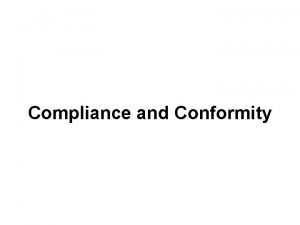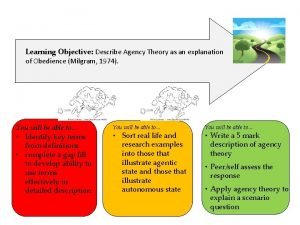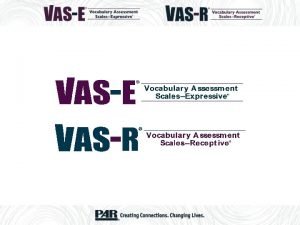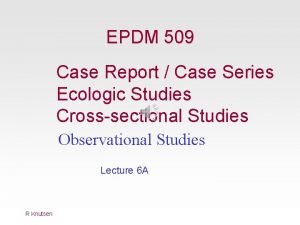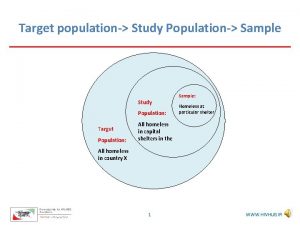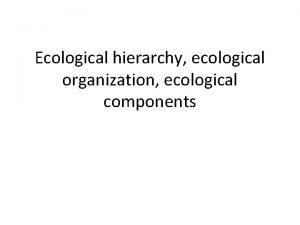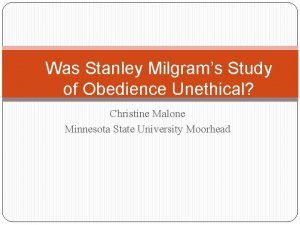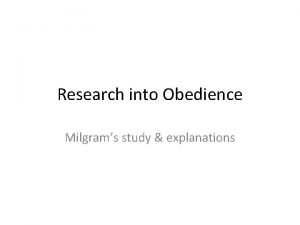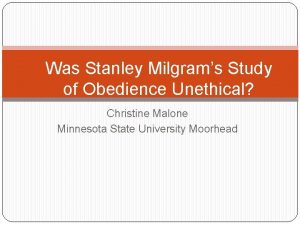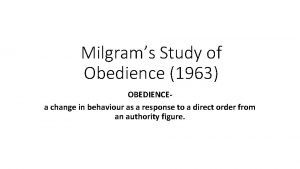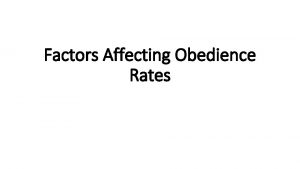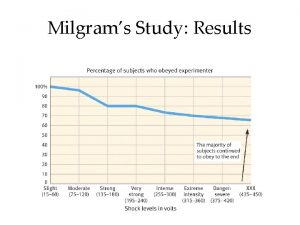Ecological validity and Milgrams study Ecological validity Population















- Slides: 15

Ecological validity and Milgram’s study Ecological validity Population validity Task validity

What is external validity? External validity is an umbrella term, meaning that it captures more than one idea but overall it can be defined as… “The extent to which findings can be generalised beyond the context of the original study”

Ecological validity Findings that have been discovered in a laboratory (controlled environment) may not generalise well to real world settings; this is sometimes called ecological validity Ecology is about ‘habitats’; you need to think about the natural habitats in which we might see certain behaviours that we are interested in and ask would we get the same results in the real world as we did in the lab; if so we have ‘good ecological validity’.

Task validity Task validity refers to whatever it was that the participants actually had to do in the study, what was their task? Was the task similar to something that they might find themselves doing in everyday life? Often experiments involve tasks which are very artificial, meaning they were designed specifically for the study. These sort of tasks lack mundane realism, i. e. they are not the ordinary everyday sorts of things that people generally do.

Population validity External validity also refers to the extent to which the same findings might be found outside of the original intended target population, e. g. other cultures This is known as population validity. There are lots of replications of Milgram’s study in countries such as South Africa, Jordan and Australia, even Germany, the country Milgram was originally interested in. We will look at the impact of culture on obedience in another lesson. Extension; if you want to see if you can find the obedience rates in these countries and any others you can find go ahead! Find a world map image on googe images and create a ‘map of obedience’ to stick in your red book.

Milgram’s study You will need to be able to give strengths and weaknesses relating to Milgram’s study When you create your chains of reason make sure you pack them with key words such as… Artificial behaviou r Artificial task Natural behaviou Everyday r Mundane life realism Real world

Task validity Think about exactly what Milgram was asking his participants to do How common is this sort of task in the real world? Can you think of any types of people who might be ordered to harm others in their every day lives? If so, how is your example similar/different to what Milgram’s Pps had to do? Think in detail. Why are these differences important what do they tell us about the validity of Milgram’s

Ecological validity Where did Milgram’s study take place? How is this similar/different to the participants everyday life experiences? When and where are people given explicit orders in real life? How are these examples similar or different to Milgram’s study? What does this mean for the validity of Milgram’s study?

Some extra studies… Spend some time researching the following studies, you can then use their findings to explain whether you think Milgram’s study lacks external validity or not and why: � Hofling (1966) � Bickman (1974)

Applications to the real world When you are evaluating a study, it is also useful to think about whether the study has helps to understand or improve any real world situations, if it has this is a strength od the study and it also relates to external validity too The following slides provide two examples.

Explaining Holocaust behaviour Milgram’s findings have been used to explain the behaviour of Holocaust perpetrators, saying that they were just ordinary people who were driven by the desire to fulfil obligations to their superiors. However some critics argue that this explanation is not justified, e. g. David Mandel

David Mandel: Important differences � Participants were told that the shocks would cause no permanent damage, the Holocaust perpetrators knew what they were doing when they killed unarmed civilians for example. � When Milgram’s Pps realised that the learner wanted to withdraw his consent, obedience declined; the Holocaust victims clearly had not given consent to be tortured and killed � When Milgram’s Pps could choose the voltage they chose very low levels whereas many Holocaust perpetrators were eager to carry out their roles often going beyond what they were commanded to do

Cockpit behaviour: Tarnow (2000) Milgram’s findings have been applied to improve commercial airline pilot training. First officers often fail to monitor and challenge errors made by the captain due to his/her legitimate authority; they are hesitant to question the captain even when his/her behaviour is putting others at risk. Tarnow believes training first officers in how to challenge the authority of the pilot could prevent up to 20% of plane crashes. This has led to training protocols to improve cockpit behaviour and potentially save lives

Using this information in your evaluative writing You might be asked to give strengths and weaknesses of Milgram’s study relating to applications to the real world How could you use the information on the previous slides?

Extension tasks You could also see what you can find out about … � The Mc. Donalds Strip Search Scam � The Jonestown massacre � Atrocities committed by US soldiers at Abu Ghraib Always think about the chain of command, who was the authority figure
 Milgrams experiement
Milgrams experiement Milgrams 37
Milgrams 37 Agency theory milgram
Agency theory milgram What is case series
What is case series Criterion validity vs predictive validity
Criterion validity vs predictive validity Ecological validity definition
Ecological validity definition Milgram ecological validity
Milgram ecological validity Population ecology section 1 population dynamics
Population ecology section 1 population dynamics Section 1 population dynamics answer key
Section 1 population dynamics answer key Population ecology section 1 population dynamics
Population ecology section 1 population dynamics Population ecology section 1 population dynamics answer key
Population ecology section 1 population dynamics answer key Ecological succession case study
Ecological succession case study Descriptive vs analytic epidemiology examples
Descriptive vs analytic epidemiology examples Case series example
Case series example What is a study population
What is a study population Study population
Study population

